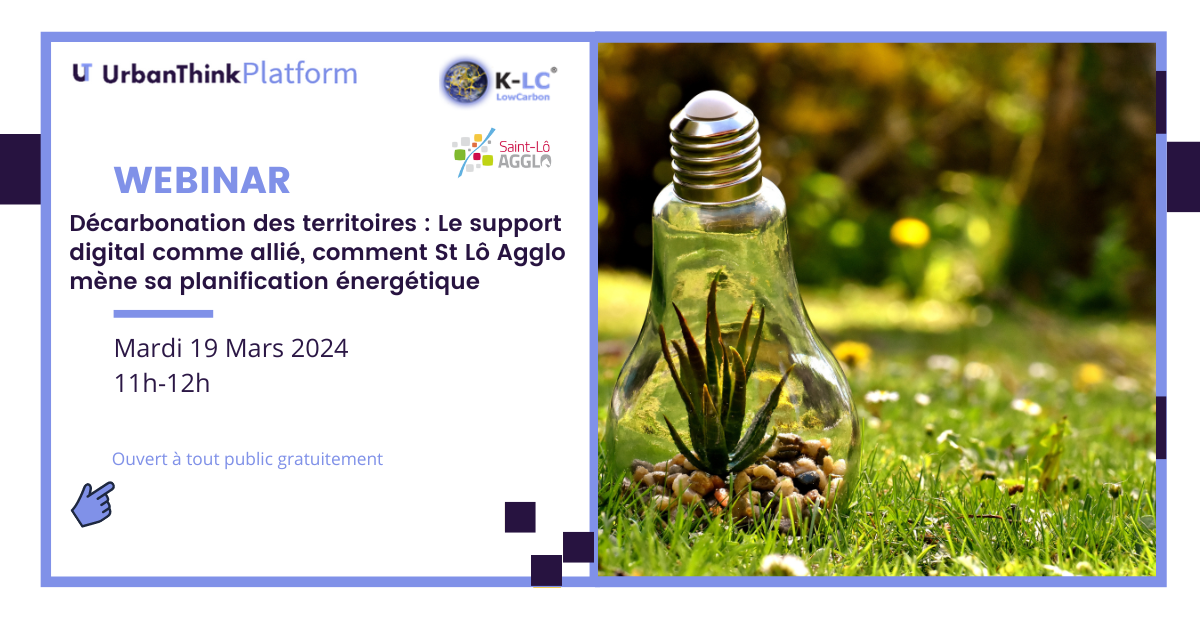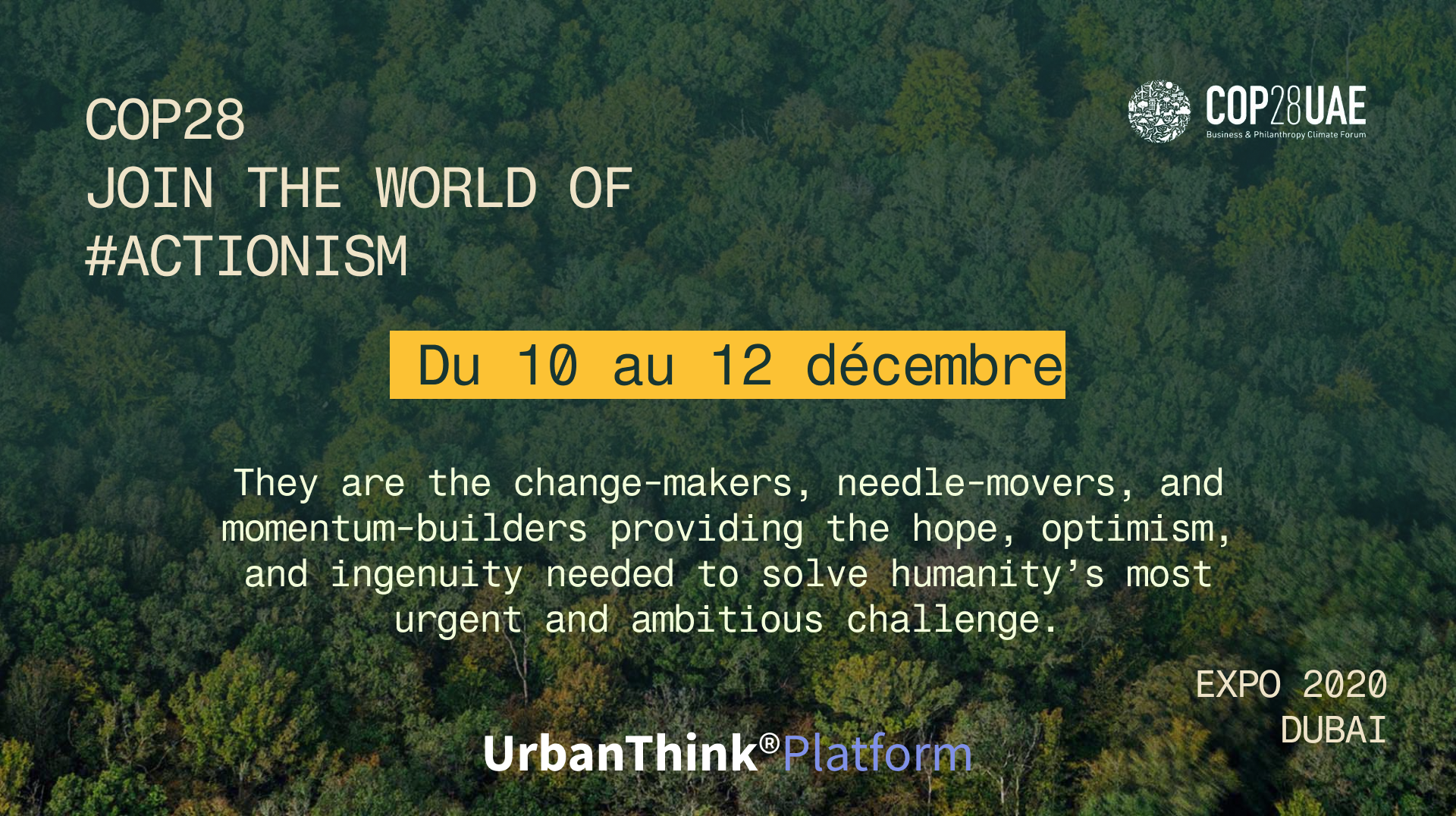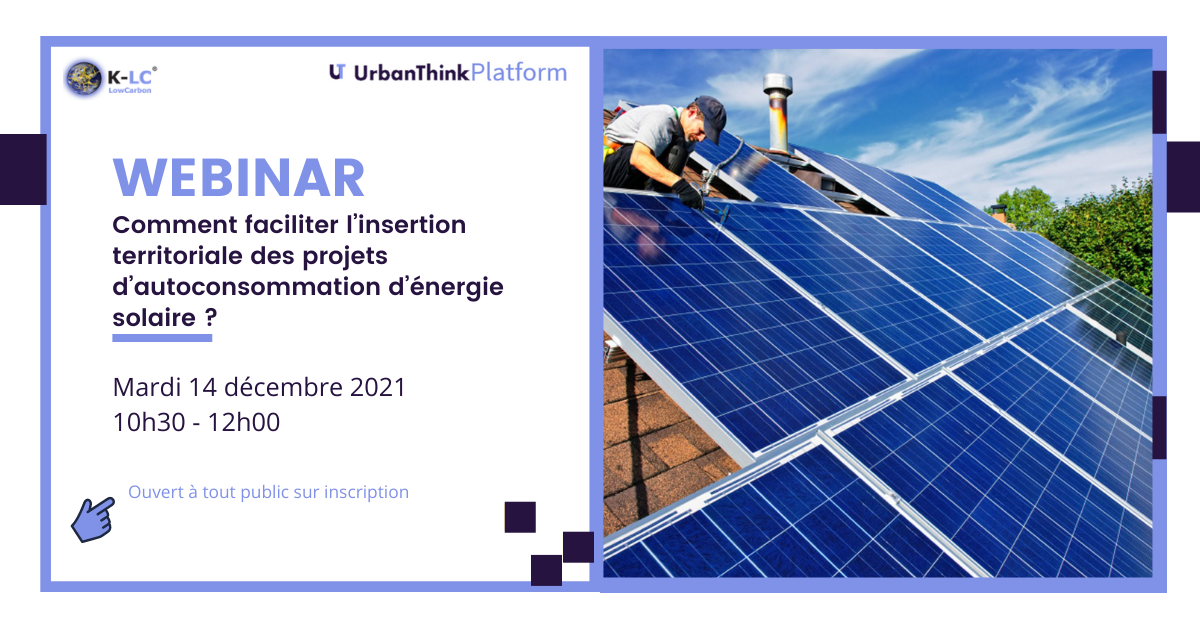
Webinar | What is the use of a PMO in a collective self-consumption project?
During this Webinar, organized by UrbanThink Platform®, Gwenaelle CARFANTAN, CEO K-LC/UrbanThink Platform, took the floor to present Athénergie®. This trusted third-party web application simulates the best solar potential scenarios for your buildings.
Pierre-Olivier DUROS, Lawyer – Mission Director (public business law and energy) at EY Société d’Avocats, spoke to present the legal framework of the PMO and its role in the governance of the collective self-consumption device of “smart-grid” energy mutualization on the scale of urban blocks and produce available and cheap energy.
Moderated by
Louis Kadryl YEMBI-YEMBI, UrbanThink Platform project manager
Liste des intervenants :
- Claire PERON (Territorial Manager, Ille et Vilaine and Morbihan)
- Julien JACQUET (Assistant to the Territorial Manager, Morbihan)
- Pierre-Olivier DUROS (Lawyer at EY, Lawyer company)
Questions raised :
Is it possible to quantify MMS between the public and the administered?
Today, it’s mainly local authorities that have taken up the idea of collective self-consumption, but there are also citizens’ associations and private companies that are PMOs. Local authorities see the PMO as a way of integrating these citizens into the system, and not just on a patrimonial basis.
For the patrimonial model, can the PMO be the community?
Yes, particularly in a collective self-consumption scheme where the local authority acts as PMO, managing electricity production and consumption for several of its buildings.
In concrete terms, how is a site’s surplus production valued/counted for the consumer (in the PMO)?
The producer is free to set his own prices, but in a collective self-consumption operation, consumers must be willing to buy this energy. As a result, the value of the producer’s injection generally comes from an agreement reached within the PMO between the producer and the consumers, on the price of the energy resold by the producer to the consumers. If there is a surplus that cannot be sold to consumers, this surplus is valued for the producer with its own surplus buyer.
The energy is metered, via the system of allocation key chosen by the PMO of this energy between the consumers. The metering is done via communicating meters and is ensured by Enedis, which transmits all the necessary data to the PMO.
How does the consumer receive his electricity gain?
The consumer will pay his energy supplier, and will have deducted from his supplementary supplier’s bill the part he will use in the operation. And this self-consumed part also forms part of the billing, and this part (self-consumed) is also the subject of fracking, and it’s a billing that will come from the producer of the operation. His gain will be the differential between the energy he pays for from the grid and the energy he pays for as part of the operation.
Does every consumer have to have the same electricity supplier?
Consumers are free to choose their electricity supplier and to change whenever they wish.
Does the PMO have to have a dedicated electricity supplier to act as Balance Responsible Entity between each PMO member? If not, who is the Balance Responsible Entity?
In a collective self-consumption operation, there is one balance responsible per producer and per consumer. The PMO itself does not appoint a Balance Responsible Entity. On the other hand, the producer must designate a Balance Responsible Entity as part of his “card-injection” contract, and consumers must also designate a Balance Responsible Entity for their sub-drawing, but generally this Balance Responsible Entity is the top-up supplier.
How is the tariff for consumers negotiated within the PMO? Does it have to be the same for everyone?
The price of electricity is freely set by the producer, but it is possible to provide for different prices or priority consumption rules for production, particularly when consumers have contributed to the financing of photovoltaic installations.
Is it possible to switch from a self-consumption project to a collective self-consumption project?
Yes, it’s perfectly feasible, and it’s also possible to convert a project with total surplus sales (i.e. a project that sells all its energy production to the grid) into a collective self-consumption project, even within the framework of projects that are subject to the compulsory purchase obligation of the S.21 decree. It is also possible to stop a collective self-consumption project and regain the right to purchase electricity under the arrêté S.21 .
Is it possible for a local authority to resell electricity (to EDF or local consumers or virtual batteries)?
Yes, local authorities participate in collective self-consumption schemes as producers. The difficulty arises when the local authority wishes to participate as a consumer in a collective self-consumption scheme. Until now, there has been legal uncertainty, but this is now being resolved, as the Senate and National Assembly have adopted new provisions in the Energy Transition Bill that will amend the Energy Code to allow local authorities to supply themselves with electricity under collective self-consumption schemes, while complying with public procurement rules.
How much does a PMO cost? I imagine that the requirements for this structure call for special, and therefore costly, skills. Are there any companies that do this for a living?
From a strictly formalities and administrative obligation point of view, and if we don’t take into account consulting fees, it all depends on the legal form of the PMO you choose: an association costs around a hundred euros, and a SAS-type company, a few hundred euros. There are indeed players on the market to manage PMOs, to handle all the invoicing and administrative obligations incumbent on the PMO.
How can we study the feasibility of new construction projects (e.g. ZAC: ZAE) when consumption profiles are not known, and projects are spread out over time?
“It all depends on what type of program we have, the case being referred to as a ZAC creation… At the program preparation stage, there are always intentions to develop surface area and square meters. So when it comes to cases like this, for example, we’re going to work on the St Sulpice ZAC, which is a “frugal” ZAC and which wants to go into this system, into this somewhat anticipatory look at capacity. So we’re going to work with ratios at this stage, because we’re well upstream. Then, as things progress, which is another advantage of the subscription-based application, we can reactivate and update the data as and when it becomes clearer. Once the program is set and we know exactly what the buildings will be used for, and what surface areas will be dedicated to them, we can refine this potential production better and better. The challenge for a ZAC is to see what production potential is needed for this PMO. We also have a file like that where we combine what already exists because that is also the interest of working very upstream, is that we will perhaps also identify profiles of producers on existing buildings. And there will be no more neighborhood problems because the producing building can very well be located in the existing district, but also in the future district. There will necessarily be compensation on both sides and consumers on both sides. The challenge is therefore to get everyone to agree on the same benefit, that of saving energy and that is super virtuous!
How much are the advisory fees?
The amount of advisory fees is assessed on a case-by-case basis and depends on the project and the nature of the support needs (legal structuring, creation of the PMO, drafting of the electricity sales contract). A quote can be sent to you free of charge if you wish after an initial discussion on your project.
How much does it cost for a company to manage PMO?
The management costs of the PMO depend on its legal form (Association, SAS, etc.) as well as the possible use of an external third party (service provider) for the management of the structure and the completion of administrative formalities.








